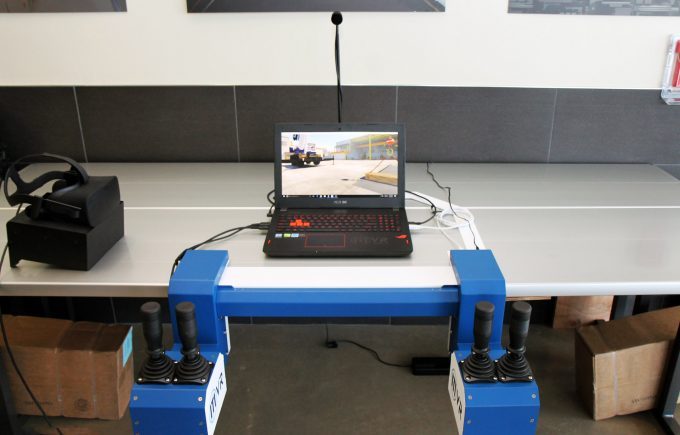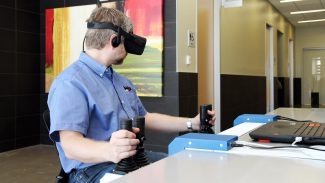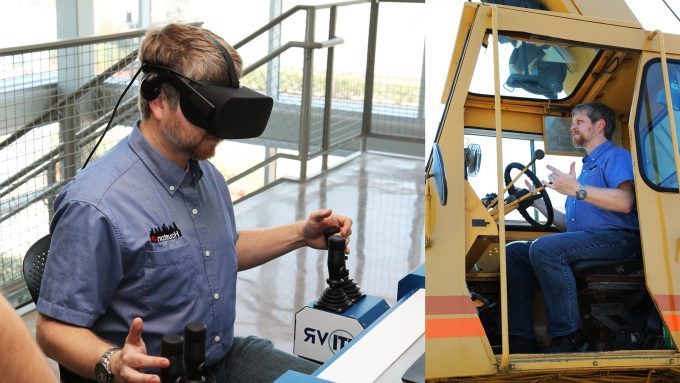Last week, I traveled to the Houston Area Safety Council in Pasadena, Texas, to put Industrial Training International VR’s new crane simulator through its paces. While ITI has been training crane operators, riggers, and signallers for 30 years, the inclusion of VR in their training programs is a recent development. To test the effectiveness of their VR crane simulator ITI offered to let me—someone who has never operated heavy machinery in their life—spend an hour training with the system and then apply what I learned to operating an actual crane.
Guest Article by Eric Liga


Unlike traditional simulators, which physically replicate a crane’s cab, surrounded by oversized monitors, ITI’s VR crane simulator is compact and rather modest looking. A laptop outfitted with a GTX 1070 drives output to an Oculus Rift, and a metal bracket with four joysticks (interchangeable to match a range of crane brands and models) attaches to any available table using a pair of clamps. The simulator weighs 30 lbs and packs neatly into a rolling Pelican case (at a total of 68lbs) for transport, making it reasonable to take the simulator to on-site locations for training or evaluation of job candidates.




Paired with a monitor instead of a VR HMD, the simulator was functional, if unexceptional. Adding in the VR headset, however, moved the experience into a different category. The addition of depth perception made understanding the motion of the crane’s distant chain far easier, and being able to glance up to check the boom tip, or lean around to check mirrors made the experience much more comparable to actually operating a crane.
Having never operated a crane before, let alone any type of heavy machinery, a number of the required skills turned out to be neither easy nor intuitive for me, and my initial forays in the simulator were less than promising. Suspended loads swung perilously close to signalmen or knocked over boxes and barrels. Virtual overseers chided me for taking too long or setting down loads too hard. By this point, Caleb Steinborn, ITI’s Product Manager of VR Simulations, may have begun to regret ever offering to let me operate a real 22 ton crane after the VR training.
One challenge for me was “booming up and lowering the load.” This involved maintaining the cargo at a set height while angling the boom arm up. Imagine the motion of a lure at the end of a fishing line: when you angle the fishing pole up, the dangling lure moves up with it. On a crane, an operator must extend the chain (hoist) at the same rate as the boom would be raising it, to keep the load level while maneuvering the boom at the same time. This may also need to be done while rotating the boom, in which case the operator must manage two joysticks with one hand and a third joystick with the other.
While the simulator’s full training sequence includes over 18 hours of content, I only sampled one or two scenarios from each unit, completing a heavily abbreviated course in just under an hour. The final test, a simulation of the National Commission for the Certification of Crane Operators Z-Corridor Practical Exam, required me to guide a suspended barrel through a zig-zag corridor lined with tennis balls balanced on poles. Knock a ball off of a pole? You fail the test. Bump the ground with the barrel, or raise it higher than the short length of chain trailing below it? You fail the test. Take longer than 4 minutes to complete the task? Fail.
Could I “boom up and lower the load”? Yes.
Could I “catch the swing”? Yes.
It’s worth noting that ITI’s development partner, Edmonton-based Serious Labs, took the software side of ITI’s crane simulator from concept to final product in 8 months. Doubtless, this was aided by the ability to reuse assets from other simulators (the Aerial Work Platform simulator shared much of the same environment), but the end result was impressive nonetheless.
ITI’s VR crane simulator will officially debut at ConExpo in Las Vegas and will begin shipping to clients in the latter half of March.
Photography by William Golden, Director of the Immersive Technology Conference.

